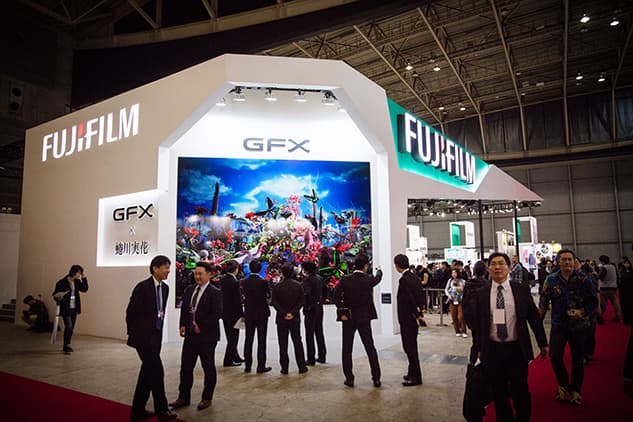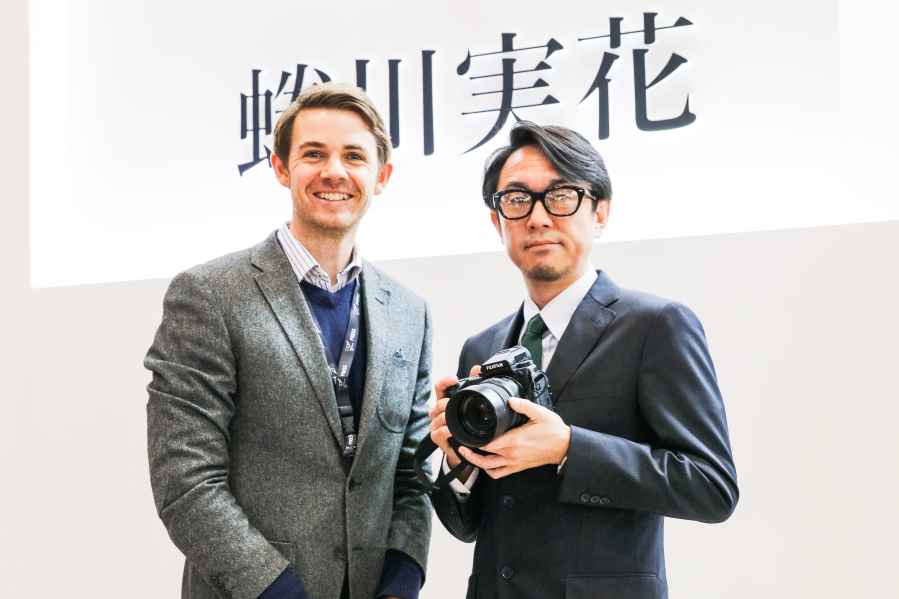There was a huge amount of interest in the new GFX medium format camera on Fujifilm’s stand at CP+ 2017. During our visit we met up with Mr Makoto Oishi, Manager of Fujifilm’s Sales and Marketing Group, Optical Device and Electronic Imaging Products division to discuss all things GFX and Fujifilm X-series related.
Interview conducted on the 24th February 2017 (10:30) at the Intercontinental Grand Hotel, Yokohama, Japan
AP: Fujifilm had a big year last year. How much of the success of 2016 do you put down to the launch of the highly acclaimed X-T2?
MO: With the X-T2 we developed new technology, not only for this camera but also for the X-Pro2. We developed our own new sensor and new processor, which come together to produce high image quality and an improved performance. This combines with the capability of 4K video. Its been very successful for us and we’ve had a great reaction from many users. We’ve sold more X-T2’s than we ever expected.
AP: What has Fujifilm done to resolve the stock issues of the X-T2 around the world? It’s our understanding you couldn’t make them fast enough?
MO: As you know, last year we had a big earthquake. We experienced some issues with our supply chain, not only with regard to the sensor but also with some semi-conductor devices and EVF and so on. From this year we’re in a better position and we have enough stock.
AP: Is there still a performance gap between DSLR and mirrorless with regard to autofocus speed and accuracy?
MO: DSLR still has advantages with their dedicated phase-detection autofocus. Some mirrorless cameras are really starting to catch up and we know there are areas of our technology that we can improve.

The Fujifilm stand at CP+ 2017 on day one minutes before the show opened to the public
AP: Would you go as far as saying the X-T2 is one of the finest cameras Fujifilm has ever made?
MO: Yes. The X-T2 has become very famous in our lineup of cameras, but it’s important to understand we have a pair of flagship models in the X-series. The X-T2 and X-Pro2 have very different styling, but they’re both our flagship models.
AP: Some users of the X-T2 are slightly disappointed that the camera doesn’t have ISO control added to the quick menu, or better still, the option to hold a function button and adjust ISO on the fly without having to pull my left hand away from supporting the body or a large lens. Why did you decide not to include this feature?
MO: We listen very carefully to our requests from our customers and we took on board about what they said about the X-T1. We should consider something for what you mention, maybe a firmware upgrade.
AP: The X-T2’s power booster is an excellent idea. It charges the batteries loaded within the booster but not the battery that’s located in the camera? Why is this and is it possible?
MO: It all comes down to the hardware structure. It’s difficult to incorporate, but it is possible.

Visitors to CP+ 2017 listen to a presentation about the new GFX 50S on the Fujifilm stand
AP: How do you think the camera market is likely to be affected by currency fluctuations making the Yen comparatively strong versus the Pound and Dollar?
MO: The Yen is still at a high price against dollars and pounds. The forecast is looking better, not only for Dollars but also the Pound. There have been a lot of big changes to the pound. The euro is becoming a bit better than last year.
AP: What is your strategy for growth in the mirrorless market? What do you need to do to differentiate your products from rival manufacturers?
MO: The mirrorless market should increase more. Nobody seems to care if a camera has a mirror or not in their camera anymore. It simply doesn’t matter.
AP: Do you think DSLR’s will run alongside mirrorless or do you think mirrorless will overtake DSLR completely?
MO: It’s my personal opinion that I don’t think everything will be mirrorless. I don’t think so. Maybe fifty fifty. At the end of the day it’s customers choice.

Fujifilm enforced an airport-style queuing system on their stand to deal with the hordes of visitors
AP: Do you see the GFX 50S being a specialist, niche product or one that has broader appeal beyond professional photographers?
MO: Of course our target audience is professional photographers who carry out landscapes, fashion and commercial work. We want to expand the mirrorless market. No body cares about the format anymore, even 35mm full-frame. The GFX system is very small and compact in its size. It’s the customer’s choice whether they choose, APS-C, full-frame or medium format, but medium format gives you a powerful feeling.
AP: There has been some rumours recently of Fujifilm thinking about a fixed lens GFX-style medium format camera in the future? Have you got anything to say about this?
MO: Unfortunately we cannot say anything about future products. We have many requests from dealers and customers all the time.
AP: Adorama has announced Fotodiox Pro Adapters for Fujifilm GFX. What’s Fujifilm’s take on this?
MO: It looks like a good adapter. We (Fujifilm) have never contacted them so I don’t know how or why they’ve developed it. So many users have so many lenses that they may want to use on the GFX body. We have of course developed our own X-mount adapter for the GFX system.

A huge print demonstrating the GFX 50S’s capabilities is admired by Fujifilm representatives
AP: Can you confirm the GFX 50S is the first camera in a series of GFX cameras?
MO: Yes, it is.
AP: Will you be able to keep up with the demand for the GFX 50S?
MO: It depends on the number of people who buy it, but of course we should. We’ve taken more pre-orders that we expected and now we’re making a big effort manufacturing the camera. The X-T2 has big demand and with the GFX there’s more demand than we expected.
AP: You’ve recently announced a new lens roadmap for X-mount indicating a telephoto prime for the X-series coming in 2018. This is an area that Fujifilm seems to have avoided before. Why is this?
MO: It’s all about priority and market size. A telephoto prime is more for professionals and we want to make sure we support professional sports and wildlife photographers. When we announce our new telephoto prime we also need a higher performance body.

The new Fujifilm X-mount lens roadmap was on display for all to see
AP: Will the focal length be longer than 200mm and will it be optically stabilsed?
MO: We’re still thinking about the focal length and the aperture. There’s a big difference between a 200mm f/2.8 and a 200mm f/2 – they’re totally different. We need to carefully think about what focal length is going to be best for sports and wildlife photographers.
AP: You already have a wide angle zoom in the form of the XF 10-24mm f/4 R OIS. The wording ultra-wide-angle suggests it’s going to be wider? Rumours say it’s going to be an 8-16mm f/2.8 lens?
MO: For now we’re just showing the roadmap and not saying more than that. The next lens may be wider.
AP: Is Fujifilm committed to the fixed lens APS-C compact area of the market?
MO: The X70 has almost reached the end of the line. The X70 was successful last year. We need a small fixed lens compact in our lineup. It (X70) got a good reaction. It compliments our X-mount cameras.

Fujifilm’s new ‘MK’ Super 35 cinema lenses for the Sony E-mount and X-mount were on display
AP: Many photographers loved The X-E2 and X-E2S. Is an X-E3 on Fujifilm’s to do list?
MO: I can’t say. We know a lot of people are using the X-E1, X-E2 and X-E2S. Some users love the styling and its smaller size compared to the X-Pro2. With the strong demand for X-E series cameras we have to think seriously about the future lineup.
AP: How successful are the entry-level models in the X-series?
MO: Last year we also announced the X-A3, which has proven particularly popular in Asia. The X-A3 is incredibly popular in Asia, especially Thailand.

The public queue up to get their hands on the latest GFX and X-series models in Fujifilm’s lineup
AP: What’s Fujifilm’s strategy for the remainder of 2017 and looking forward to 2018?
MO: Our first priority is to develop some kind of new technology. This new technology can then bring benefits to the end user. We want the market share of mirrorless will continue to rise and our vision is that we (Fujifilm) should get even bigger. Ten years ago we played a big role in the compact camera market, but we were dealing with completely different customers. Now we have more enthusiasts and professionals interested. Our products are totally different from ten years ago.
AP: Fujifilm do everything themselves, from designing the sensor and processor to creating the body of their cameras. How important is it to undertake the whole process?
MO: Good question. I think we’re in a better situation than some others manufacturers.
CP+ 2017 camera and photo imaging show report
Visiting the CP+ camera and photo imaging show in Japan was a great opportunity to see many of the major players in the market exhibiting their latest products. You can read our roundup of what we saw on the opening day by reading our CP+ 2017 Day One News Round-up. To check out what we came across on day two of the show we have also posted a CP+ 2017 Day Two News Round-up.








